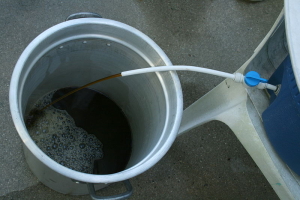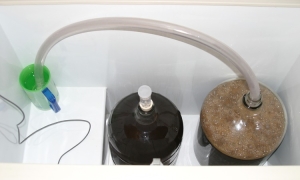Although the most critical stage for measuring pH in brewing is the mash, there are other steps where testing the pH is a good idea. After all this work, you better make sure you’ve got a darn good beer, right? We just want the best for you and your beer, so let’s take a look at what’s next.
What is Wort?

After the mashing process, the next step is sparging. Sparging is where hot water is run through the grain bed to extract a sweet liquid called wort. Wort contains the fermentable sugars from conversion. The wort is boiled and fermented by the brewing yeast to produce alcohol.
That’s right. The good stuff is finally in the foreseeable future.
Testing Wort pH
Wort pH has a strong effect on clarity, hop bitterness and malt profile, and similar to mash, the ideal pH of wort is between 5.0 and 5.5.
Wort pH and mash pH are usually similar, but if your sparge water is alkaline, the wort pH may be higher. In our opinion, testing the pH of wort is worthwhile, and it’s very similar to testing and adjusting mash pH, so there’ s not a huge learning curve here. And once again, our Beer pH Test Strips are to the rescue for an inexpensive and accurate pH test.
Remember from our previous post that temperature plays a role in testing pH. Measure the wort at room temperature, and adjust your pH reading accordingly.
Just like mash, the hotter the wort sample, the lower the density and pH appear to be. Wort at a temperature of 149°F will have a pH about .35 lower than that measured at 68°F. (Sources: New Brewing Lager Beer and Standards of Brewing)
The same chemical reactions, primarily between calcium and phosphates that helped you establish the correct mash pH can also help you establish the proper wort pH. If your pH is too high, adding a small amount of calcium ions, such as calcium chloride or calcium sulfate will decrease the pH. The pH can also be decreased with acids, such as phosphoric acid.
On most occasions, your wort pH will be the same as your mash pH, and you won’t need to make any adjustments.
pH of Fermenting Beer

Last but not least, we recommend checking the pH of your fermented beer. Once fermentation starts, you can expect the pH to drop quickly. The fermented beer nears its final pH value after about 24 hours.
In general, ales have a slightly lower pH than lagers. The typical pH value for ales is between 4.0-4.5 and between 4.4-4.7 for lagers.
We think it’s important to check the pH of fermented beer for a couple of reasons. First, different yeast strains have different characteristics. If you usually work with a select group of yeasts, it’s a good idea to check the pH of your fermented beer just to get an idea of what those yeasts are giving you.
Second, if you find that your pH is inconsistent over consecutive batches, it might mean you have contamination, and you should consider getting a fresh yeast culture.
When you measure the pH of fermented beer, remember to degas the sample before measuring. The carbon dioxide will affect pH, resulting in a lower pH reading. The easiest way to degas a sample is with a blender or mixer.
The best way to learn from your brewing experience is to measure and record results at different stages. You don’t want to finish with the world’s best beer, only to have no idea how to repeat that result. Make sure you’re not a one-hit-wonder, and check the pH of your beer at various stages in the process.
Next week, we’re meeting up with Cultures for Health to discuss a different use for our Wine pH Test Strips: Testing the pH of Kombucha Tea.







Leave A Comment